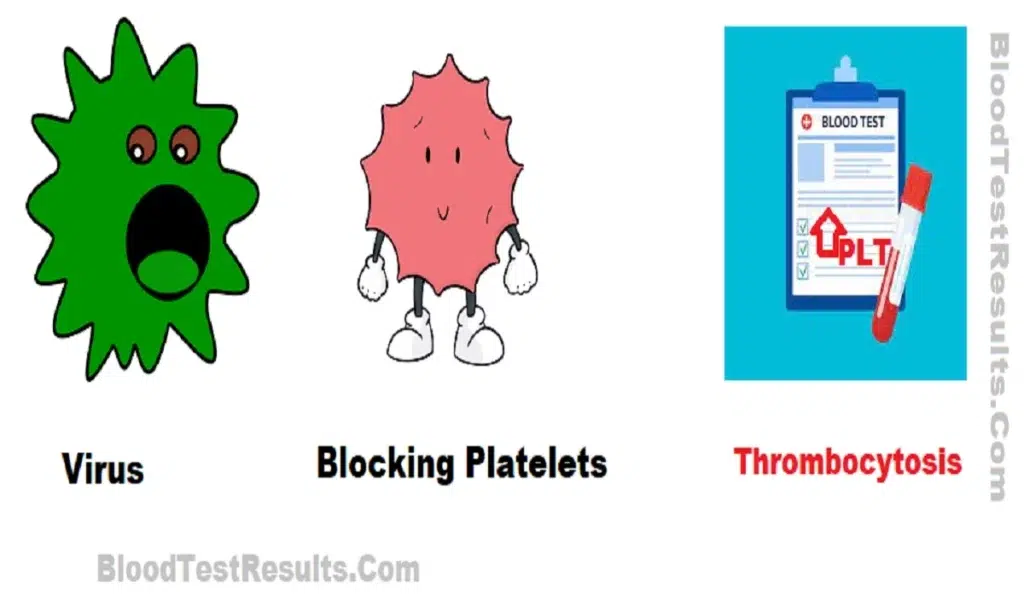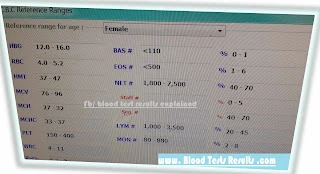Can Viral Infection Cause High Platelets Count in my blood tests? What viruses affect platelets level?
The commonest reason of elevated platelets count is the infection and inflammation, to be clearer: Viral infections that cause inflammations of the digestive system often cause an increase in the platelet count (medical term is thrombocytosis), but viruses that affect the upper respiratory tract (lungs) usually cause a decrease in the number of platelets (Thrombocytopenia in medicine books) in the blood cell count (FBC), but if a virus causes liver or skin infection, it is not specified if it will elevate or decline the platelet count, and below are the details to better understand the lab test results for you and your family.
Go there, if you don’t know what is the complete blood count
What are viral diseases?
The ailments that caused by a virus, the virus is the smallest living pathogen yet
What is the meaning of a viral infection?
It is a condition in which a harmful virus gets inside your body to reproduce more copies of the original virus, thus the human cell acts as a copier machine to the viruses, commonest viruses are those causing the common cold (flue, influenza) “e.g. rhinovirus, coronavirus, and adenovirus”.
Examples of common viral infections include:
You can press the name of the virus to read more detailed information about its effect on platelets count.
- Human papillomavirus (HPV) and herpes simplex virus (HSV) are responsible for warts and skin infections.
- Encephalitis and meningitis diseases by Enteroviruses and the (HSV).
- West Nile virus
- Chickenpox and shingles
- Human immunodeficiency virus (HIV the causative of AIDS)
- Infectious mononucleosis.
- Mumps, measles and rubella.
- Flu viruses
- COVID
- Hepatitis B virus
Read more about AID HIV viral infections
Symptoms of viral infections commonly are fever and allergic reaction of some degree.
Causes of viral infections may include inhalation of breath droplets if someone infected sneezed or coughed near you, ingestion the contaminated food, got bitten by infected creature.
Can a viral infection causes high platelet count?
Yes, many of viral infections can cause thrombocytosis (elevated blood platelets count), for instance most viral infections to the abdominal organs result in elevated blood platelets of some degree. Interestingly, there’re viruses that reduce or mute the immunity power by shutting down the bone marrow production of platelets or by induce the production of defective platelets, or just consume plenty of platelets in the resultant blood clot formation that occasionally occurs during severe level of the respiratory viral infection. Therefore, most known viral infections is associated with thrombocytopenia (low platelets count in the CBC test) instead of thrombocytosis (high platelets count). Keep reading to discover more important details.
Why do viral diseases cause high platelets in the blood?
Probably you’re wondering how the viruses can elevate platelets level in the blood, what’s the link? Scientifically blood platelets can sense the entrance of the virus antigens (proteins found on the surface of the virus) into the blood through their chemicals, those chemical later activates more platelets in order to clump and prevent the virus from infecting the cell and multiply, but some clever viruses (e.g. COVID-19) know that and stop the platelets from working at the first step, therefore the immune system recall the lymphocytes that specialized for virus control, then plenty of lymphocytes come, identify and secrete chemicals the lyse the virus. Therefore, the elimination of viral infection, thus why platelets may not have elevated in the blood after some vial infections.
Accordingly, the real reason of elevation of platelets count in respiratory viral diseases is not the virus infection but it is the accompanied bacterial infection, because virus’s infections are known to cause reduction in the immunity system, therefore, many bacteria can exploit the chance to infect the lungs or the nearest organ and lead to elevated WBC and PLT in the blood test results.
The CBC test may show elevated platelets and elevated lymphocytes count in some viral infections, but the COVID virus when was new infection used to reduce both platelets and lymphocyte count in CBC test
How long does platelets high count last after viral infection?
A viral infection usually lasts only a week or two and the body can perfectly clear it on its own even without antibiotics except some dangerous viruses that require admission at ICU or if the body infects with secondary bacterial infection that require antibiotic infusions. During the virus activity period the platelets may go higher up to 600,000 then down to near the normal 300,000 after recovery, so that you may not worry too much. in COVID infection the patients usually take one week for infection to peak in which platelets count appears reduced not elevated and another week for infection to decline and the platelets level used to appear normal after COVID recovery to be reassured.
What do the blood test results mean?
Elevated blood platelets level in FBC test when you have a viral disease is a marker of viral activity, in other words, viruses that reduce the number of blood platelets: the virus has moved from the stage of latency to the stage of activity in which it multiplies and thus disables the platelets so that they do not conflict with its pathological activity inside the body.
In the case of viruses that cause a noticeable rise in blood platelets in the test: this means more destruction of the virus in the tissues of the body, and therefore platelets increase to resist this deliberate destruction.
Elevated platelets count as a consequence of viral disease doesn’t necessarily mean or indicate a cancer or serious medical condition unless other lab results state that.
In the lab report you may notice a red flag or abbreviated letter such as “A” which means abnormal result, or the letter “H” near the number of platelets which highlights the elevated platelets results, the opposite meaning for the letter “L” next to platelets value which marks the lower than normal platelets levels, if your report may include the word “outside range” which means the platelets level exceeds the normal limit, sometimes labs print reddish “C” letter next to platelets count to mark the very high or extreme levels which require rapid medical intervention. If your lab printout “PLT AGG” word in your results you must retest again because this means your count is invalid. Know more meanings of red lab flags

Does COVID virus increase platelets count?
No, the opposite is true. COVID virus can exploit the immune system so powerfully and lead to the so-called immune storm, in which dangerous blood clots may occur in lungs and prevent the patient from breathing and lead to death. Accordingly, bone marrow may release too much platelets or the virus may delay or obstruct the platelets production in addition to excessive consumption, and therefore a severe decrease in the number of platelets appears in the blood test of a COVID patient, not an increase in platelets.
Elevated D-dimer test results along with the deficiency of platelets (thrombocytopenia) and low lymphocytes (leucopenic lymphopenia) are the key indicators of the cytokine storm that evolve due to the severity of coronavirus COVID19.
In 2022, COVID-19 from the first stages of the epidemic (first known strain) has become one of the usual and common cold viruses because the virus nearly infected all the populations of the world, and almost all the planet’s people become naturally or artificially vaccinated. Therefore, nowadays if you infected with COVID-19, your blood test results may not show low platelets or low lymphocyte, instead you may notice normal platelets count with COVID-19 infection as many people have, also the lymphocyte count increases during the episode of COVID-19 which indicate that our bodies have identified the virus.
Dengue virus
Does viral fever and dengue virus elevate platelet count?
The Kids who have fever (body temperature >100F, or >37.5C) without apparent cause may be infected with one or more of virus infections, the virus can go on its own or may accompanied by bacterial infection that require antibiotics.
Examples: Ebola, dengue fever, Marburg hemorrhagic fever, Lassa fever, yellow fever, and Crimean-Congo hemorrhagic fever.
Treatment is by simple methods of drinking and messaging the body with lukewarm water and may eating the popsicles help as well.
The viral infection symptoms (chills, weaken, dehydration, etc.) can last for few weeks even though if the fever resolve within few days because it depends on the type of virus that causing the disease.
Is viral fever reduce or increase the platelet count?
Most viral infections can reduce the count of blood platelets. For instance, the dengue fever that caused by dengue virus, this virus can suppress the bone marrow production of platelets, therefore the platelets count in the CBC test will appear low (thrombocytopenia, lower than 130,000), thus why the dengue infected people have low blood platelets.
Can flu virus elevate platelet count?
No, the infection of flu virus (Influenza A(H1N1) virus) leads to impairment of the function of platelets, therefore the platelets count may appear normal or decreased in the CBC test (below 140,000). Other lab results may include low mean platelet volume (MPV), high APTT and elevated levels of D-dimers, that’s a handful of reasons for why the body weaken and the breath shorten during the flu infection.
If the normal count of platelets is 150,000 to 400,000 per microlitre of blood. In viral fever, the platelets level appears lower than normal, it can be reduced up to 80,000 or less, but you should not worry because it must return to the normal levels once the patient healed.
Can Chickenpox and Shingles affect platelets count?
Varicella infection is one of viral infections that are familiar of induced thrombocytopenia in adults.
Chickenpox is a highly contagious disease, the responsible is the infection by varicella-zoster virus (VZV). Chickenpox known by itchy, blister-like rash that appears on the chest, back, and face, and then spreads.
Thrombocytopenia level in chicken pox about 25 x 10(9) /L or greater, but the low platelet count during varicella infection usually does not cause bleeding tendency (i.e. normal coagulation time test), but when the count become normal? Typically, the platelets count improves with the treatment of varicella.
Does chickenpox cause low or high platelets?
Acute thrombocytopenic purpura (ITP) is one of the chickenpox markers in the blood test count, low platelets level is a common secondary to chickenpox (secondary thrombocytopenia). Symptoms usually disappear in about 6 months, sometimes the treatment is not needed as the body clears the varicella virus within few weeks.
Do HIV virus lower or elevate platelets?
Does HIV affect platelet count? Human immunodeficiency virus (HIV) is the responsible virus for the AIDS disease (Acquired immunodeficiency syndrome), the HIV virus acts by hiding inside the circulating platelets themselves and can cause defects in the mother’s cell of the platelets (the megakaryocytes), that’s why platelets level decline after late active HIV infections (AIDS).
When HIV AIDS patients have thrombocytopenia?
According to many studies out there, below 15% of HIV patient may develop mild thrombocytopenia (slightly low platelets) in the first stages of the viral infection, but if the patients reaches the AIDS stage (the most dangerous), the platelets count is moderately and even markedly decreased.
Read more information about What do AIDS blood test results mean?
Because there’re many other types of viral infections, we can’t cover all details in this post, however, we’re welcome any question sent to us and appreciate your trust.
